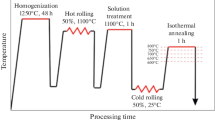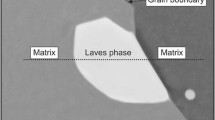Conclusions
-
1.
The basic reason for anomalous grain growth in 42KhMFA steel in heating to 900–1000°C is not the melting method but the solidification conditions promoting the occurrence of macro- and microchemical inhomogeneities causing nonuniformity in second-phase particle distribution.
-
2.
Different production methods of melting, forging, and rolling with small degrees of deformation do not change the tendency of 42KhMFA steel to mixed grain size in heating to 900–1000°C.
-
3.
The greatest degree of mixed grain size is observed in heating case 42KhMFA-ÉSR steel (retarded cooling of the ingot) to 960°C but it is almost completely absent with the same heating of samples from an ingot rapidly cooled in solidification.
-
4.
Forging with a large degree of reduction and subsequent annealing eliminates the tendency toward the occurrence of mixed grain size in 42KhMFA steel in heating to 900–1000° C regardless of the method of melting it as a result of the more uniform distribution of second-phase barrier particles on the grain boundaries.
-
5.
The formation of ruptures in the austenitic grain boundaries and the dispersion of the brain boundaries in heating probably occur as a result of the appearance of annealing twins in areas free of barrier particles (carbonitrides, oxides, etc.).
Similar content being viewed by others
Literature cited
A. P. Gulyaev and R. P. Leshchinskaya, "The naphthalenelike fracture of high-speed steel," Metalloved. Term. Obrab. Met., No. 9, 22 (1963).
K. M. Zhak and É. N. Pogrebnoi, "The mechanism of silicon ferrite grain growth," Metalloved. Term. Obrab. Met., No. 4, 17 (1974).
M. A. Krishtal, Yu. I. Davydov, and M. I. Lerner, "The mechanism of secondary solidification in powdered tungsten," in: Interaction between Dislocations and Impurity Atoms in Metals and Alloys [in Russian], Tula Polytechnic Inst. (1969), p. 258.
A. P. Gulyaev and L. N. Serebrennikov, "An investigation of anomalous grain growth in metals," Metalloved. Term. Obrab. Met., No. 12, 5 (1978).
S. V. Zagulyaeva and M. I. Vinograd, "Austenitic grain growth in constructional steel," Metalloved. Term. Obrab. Met., No. 7, 2 (1971).
A. P. Gulyaev and L. N. Serebrennikov, "The influence of mixed grain size on the mechanical properties of 18Kh2N4M steel, Metalloved. Term. Obrab. Met., No. 4, 2 (1977).
K. M. Zhak et al., "The role of annealing twins in austenitic grain growth," Metalloved. Term. Obrab. Met., No. 3, 9 (1978).
A. A. Popov, "A theory of solidification of metal alloys," in: Problems of Metal Science and Heat Treatment [in Russian], Mashgiz, Moscow (1956), p. 5.
Additional information
Perm Polytechnic Institute. Translated from Metallovedenie i Termicheskaya Obrabotka Metallov, No. 12, pp. 27–29, December, 1981.
Rights and permissions
About this article
Cite this article
Lipchina, A.N., Nemanov, A.M. & Stratinskaya, L.V. Anomalous grain growth in 42KhMFA steel. Met Sci Heat Treat 23, 838–842 (1981). https://doi.org/10.1007/BF00712461
Issue Date:
DOI: https://doi.org/10.1007/BF00712461




